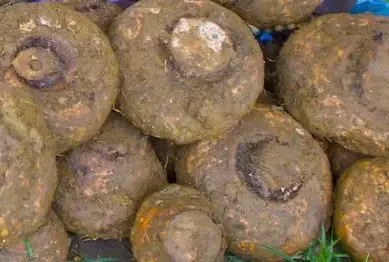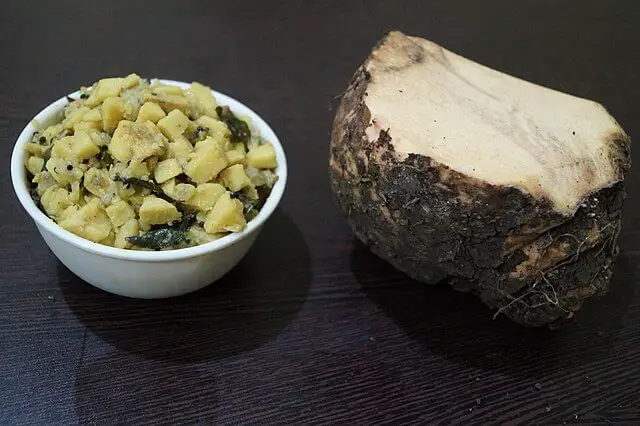
Here are some things to know about the Elephant Foot Yam vegetable, also called Suran, Jimikand, Elephant Yam or Indian Yam. The Elephant Yam or Suran is a very nutritious vegetable and is consumed mostly in Southeast Asia and India. It is much like a traditional yam, but it looks like an elephant’s foot and also has a hard surface.
There are many different ways it can be cooked and eaten. The Jimikand also has tons of health benefits. You can find a full post on the Elephant Foot Yam and all its benefits at Elephant Foot Yam (Suran, Jimikand, Elephant Yam, Indian Yam Vegetable)
Let’s look at some things to know about Elephant Yam below and what some common questions are.
Contents
- What is Elephant Foot Yam?
- How much Elephant Foot Yam to eat daily?
- How to prepare Elephant Foot Yam
- Where can I buy Elephant Foot Yam?
- How to grow Elephant Foot Yam at home
- Who eats Elephant Foot Yam?
- What eats Elephant Foot Yam?
- What does Elephant Foot Yam taste like?
- How long does an Elephant Foot Yam take to reach maturity?
- How to store Elephant Foot Yam
- Is Elephant Foot Yam Poisonous?
- Is Elephant Foot Yam good for you?
- Is Elephant Foot Yam edible?
- Final Thoughts
What is Elephant Foot Yam?
The Elephant Foot Yam is a tuber vegetable and is very nutritious. It’s consumed mostly in Southeast Asia and India, but also in Africa. It is much like a traditional yam, but it looks like an elephant’s foot and also has a hard surface.

Different names for Elephant Yam include:
- Jimikand
- Suran
- Ol
- Indian Yam
- Elephant Yam
- White spot giant arum
- Cheeky Yam
- Chena Yam
- Karunai Kizhangu plant or karunai kilangu
- Elephant Foot Yam in Tamil is known as Senai Kilangu plant or Senai Kizhangu plant
- Amorphophallus paeoniifolius is the Scientific Name
The Elephant Foot Yam has high nutritional value and health benefits. It’s even used for medicinal purposes.
It comes from the Amorphophallus paeoniifolius plant. The Elephant Yam’s flower is sometimes called stinky lily, because of the order it gives off after it has bloomed.
How much Elephant Foot Yam to eat daily?
Elephant Foot Yam is very nutritious and very good for our health. It has even been used in Ayurveda medicine for many different reasons and to help with many different problems. You can see more about these benefits in the full Elephant Foot Yam post.
Because it’s so nutritious, it’s good to eat Suran at least once a day, or for more benefits, you can add it to two meals a day or eat it as a snack as well.
How to prepare Elephant Foot Yam

Elephant Yam needs to be cooked before eating, and can be used in place of potatoes or root vegetables. It is usually cooked and eaten as a vegetable. It can also go into main dishes or Elephant Yam can be served as a side. It can also be cut thin and fried just like chips and even eaten as a snack. In some places it is smashed and mixed with salt and rice and eaten. The leaves can be cooked and eaten and is sometimes eaten with fish.
The Suran vegetable is also used in India commonly as a meat substitute. This is great since a Plant-based diet is the healthiest way to eat.
Just like potatoes, the Jimikand or Suran can be baked or mashed. Suran tastes very much like yams or sweet potatoes without the sweetness. It has a very neutral flavor in cooking and just like potatoes, it takes on the flavor of the dish it is added to. Indian Yam is sometimes pickled in certain regions. Also, it is sometimes used to make a flour that is gluten-free.
Here are some Indian Yam recipes:
- Elephant Foot Yam Recipe – Karunai Kilangu Shallow Fry
- How to Make Elephant Foot Curry in Andhra Style
- Suran Chips
- Suran Spicy Curry (Indian Yam Spicy Curry)
- Jimikand ki Sabzi Recipe
- Jimikand Curry Recipe – Indian Yam Recipe
Where can I buy Elephant Foot Yam?
If you live in India or a place where Elephant Yam is grown, you maybe able to buy it at a local market.
In the U.S. or elsewhere, it can be very difficult to find Suran. One person has said they were able to find it in the frozen section of their supermarket, with the other Indian food. But this will depend on who your local supermarket is, and this is a rare item so it may not be carried.
Another option is to possibly look for a local Indian store, and see if they sell it or know where it can be purchased.
A third option is to grow your own Elephant Foot Yams. How do you do that? You can get the seeds or bulbs off of Ebay or Amazon and grow them yourself.
Which leads to the next question.
How to grow Elephant Foot Yam at home
Here is how to grow Elephant Foot Yam at home. It can be grown either in a large pot or in the ground. It needs a humid and warm climate. The Indian Yam grows very big so you will need it to be in a space that also allows enough growth. The soil will not to be fertile, and may need manure, but one of the tutorials below uses banana peels and vegetable peels instead of fertilizer.
The top of the Elephant Foot Yam which looks like an eye, needs to be cut out and planted. After a month, a plant will grow from this bud.
The pot needs to be able to be drained and it needs a medium amount of water. Not too much or too little.
It could take up to a year for the yam to grow. Anywhere from 7 months to a year on average. When the leaves either turn yellow of fall off, it is ready to be harvested. The entire plant including the roots are dug up once it is grown and harvested.
I’ve heard that they are pretty easy to grow. You can even eat the leaves and they are nutritious as well.
The Suran plant took less than a month to grow. There should be Suran to eat within six months of that. Banana peels and vegetables peels can be used as fertilizer.
Who eats Elephant Foot Yam?
Elephant Yam is consumed mostly in Southeast Asian countries and in India. It’s also eaten in South Asia and Africa in Madagascar. People in the Phillipines also consume Jimikand, but it is called pongapong.
It is probably most popular in India in modern times. It is grown there and also used in many different Indian dishes.
What eats Elephant Foot Yam?
Elephant Yam does not have any animals that eat it in the wild. It is a tuber or root, so it is only eaten by humans after being dug up.
What does Elephant Foot Yam taste like?
Elephant Foot Yam tastes a lot like a traditional yam. It is also like a sweet potato, but without being as sweet. It’s said to have an earthy flavor with a mild bit of sweetness.
When cooked and put into dishes, much like a potato, the Suran will absorb the flavor of the dish and have a somewhat neutral flavor.
How long does an Elephant Foot Yam take to reach maturity?
It usually takes anywhere from 7 months to a year after being planted before the Elephant Yam can be dug up and eaten. It is usually around 8 months on average.
How to store Elephant Foot Yam
Yams should be kept in a well-ventilated and dark place, such as the pantry. Do not put them into plastic bags. Keep them out of exposure to the sunlight and they should last 3-4 months or so. It’s advised to not store them in the refrigerator.
Is Elephant Foot Yam Poisonous?
No, Suran is not poisonous. It has a burning or itching feeling in the mouth and throat if it is not cooked enough. This is due to its high level of oxalates.
Make sure to cook it or boil it enough to get rid of this.
Is Elephant Foot Yam good for you?
Yes, Elephant Yam vegetable has tons of health benefits. See Elephant Foot Yam health benefits for all the benefits.
Is Elephant Foot Yam edible?
All of the Elephant Yam is edible, including the leaves. As long as everything is cooked, all of it can be eaten. The actual Suran is widely eaten and extremely popular in countries like India.
Final Thoughts
The Elephant Yam is very good to eat and packed with nutrition and health benefits.
Elephant Foot Yam Video Resources
DIY HOW TO GROW SURAN / YAM AT HOME
Growing and Harvesting Elephant Foot l Chena l Suran l Jimikand
How to grow Elephant foot yam -planting the yamlets
Lance has been passionate about the plant-based diet and we have been following a whole food plant-based diet for over 5 years. We focus on health, natural healing, weight management, animal rights, and the health of the planet and environment by focusing on whole plant-based foods and sustainable practices.
Learn more at the About Me page and follow on social media at the links below.






This article has everything which is ok , but not the main thing we want to here , which is what are the list of nutrients contained in yam root? e.g vitamins minerals etc .